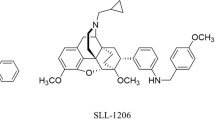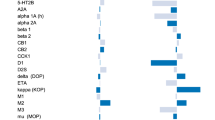Abstract
SUBSTANCE P (SP)1 has long been known to have marked effects on the central nervous system (CNS). Lembeck2 suggested that SP might be a transmitter of primary sensory impulses, an hypothesis supported by subsequent investigators3,4. Early work on SP was carried out using natural material, which unless highly purified, is known to be contaminated with bradykin or some other kinin-like material5. As bradykinin also has marked effects on the CNS, experiments carried out using impure SP may be misleading. This may account for some of the conflicting observations that exist regarding the action of SP on sensory transmission, and may also explain its interaction with opioids. Whereas impure SP has been shown to antagonise morphine6, synthetic SP was found to substitute effectively for morphine in mice chronically treated with morphine7. SP does not act like morphine in the field-stimulated guinea pig ileum8 and does not combine with morphine receptors9. Furthermore, SP has been reported to be the most potent algogenic substance known on the human blister base10. Recent reports on the characterisation and activity of enkephalin11,12 suggested that enkephalin may be acting as an analogue of SP. We have therefore examined SP for morphine-like activity.
This is a preview of subscription content, access via your institution
Access options
Subscribe to this journal
Receive 51 print issues and online access
$199.00 per year
only $3.90 per issue
Buy this article
- Purchase on Springer Link
- Instant access to full article PDF
Prices may be subject to local taxes which are calculated during checkout
Similar content being viewed by others
References
Leeman, S. E., and Mroz, E. A., Life Sci., 15, 2933–2044 (1974).
Lembeck, F., Naunyn-Schmiedebergs Arch. exp. Path. Pharmak. 213 (1953).
Krivoy, W. A., Lane, M., and Kroeger, D., Ann. N. Y. Acad. Sci., 104, 312–325 (1963).
Otsuka, M., Konishi, S., and Takahashi, T., Fedn Proc., 34, 1922–1928 (1975).
Stewart, J. M., Pharmacologist, 12, 265 (1970).
Zetler, G., Arch. exp. Path. Pharmak., 228, 513–538 (1956).
Stern, P., Catovic, S., and Stern, M., Arch. int. Pharmacodyn. Ther., 202, 259–262 (1973).
Cox, B. M., Opheim, K. E., Teschmacher, H., and Goldstein, A., Life Sci., 16, 1777–1782 (1975).
Terenius, L., J. Pharm. Pharmac., 27, 450–453 (1975).
Armstrong, D., in Bradykinin, Kallidin and Kallikrein, Handbuch Exp. Pharm., 25 (edit. by Erdos, E. G.), 434–481 (Springer, Heidelberg, 1970).
Hughes, J., Smith, T., Morgan, B., and Fothergill, L., Life Sci., 16, 1753–1758 (1975).
Hughes, J., et al., Nature, 258, 577–579 (1975).
Haley, T. J., and McCormick, W. G., Br. J. Pharmac., 12, 12–15 (1957).
Eddy, N. B., and Leimbach, D., J. Pharmac. exp. Ther., 107, 385–393 (1953).
Euler, U. S. Von, and Pernow, B., Acta physiol. scand., 36, 265–275 (1956).
Belluzzi, J. D., et al., Nature, 260, 625–626 (1976).
Bradbury, A. F., et al., Nature, 260, 793–795 (1976).
Author information
Authors and Affiliations
Rights and permissions
About this article
Cite this article
STEWART, J., GETTO, C., NELDNER, K. et al. Substance P and analgesia. Nature 262, 784–785 (1976). https://doi.org/10.1038/262784a0
Received:
Accepted:
Published:
Issue Date:
DOI: https://doi.org/10.1038/262784a0
This article is cited by
-
Neuropeptide S-initiated sequential cascade mediated by OX1, NK1, mGlu5 and CB1 receptors: a pivotal role in stress-induced analgesia
Journal of Biomedical Science (2020)
-
Alternative forms of interaction of substance P and opioids in nociceptive transmission
Letters in Peptide Science (1998)
-
Effect of the C-terminal fragment of substance (SP5?11) on neuronal activity of the dorsal nucleus raphe
Bulletin of Experimental Biology and Medicine (1991)
-
Effect of substance P and its fragments on physiological and pathological pain
Bulletin of Experimental Biology and Medicine (1988)
Comments
By submitting a comment you agree to abide by our Terms and Community Guidelines. If you find something abusive or that does not comply with our terms or guidelines please flag it as inappropriate.



